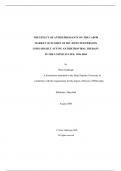Exam (elaborations)
THE EFFECT OF ANTIDEPRESSANTS ON THE LABOR MARKET OUTCOMES OF HIV-INFECTED PERSONS USING HIGHLY ACTIVE ANTIRETROVIRAL THERAPY IN THE UNITED STATES
- Course
- Institution
THE EFFECT OF ANTIDEPRESSANTS ON THE LABOR MARKET OUTCOMES OF HIV-INFECTED PERSONS USING HIGHLY ACTIVE ANTIRETROVIRAL THERAPY IN THE UNITED STATES: by Omar Galárraga A dissertation submitted to the Johns Hopkins University in conformity with the requirements for the degree of Doctor...
[Show more]



